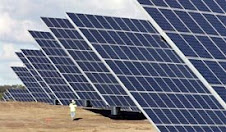As electric rates rise, people turn to alternatives
By SARAH SHEMKKUS, Standard-Times correspondent
from SouthcoastToday.com
Garry Barney hasn't paid an electric bill since last March.
Before he installed an array of 18 solar panels on the roof of his Rochester home, Mr. Barney's electric bill averaged $100 a month. After going solar in December 2003, he watched his bill drop steadily until it finally disappeared entirely early last year.
"I was tired of paying my electric bills," Mr. Barney said, explaining why he turned to solar power. "They kept going up and up and up."
With residential electricity prices in Massachusetts 13 percent higher now than they were a year ago, Mr. Barney is not alone in seeking sustainable alternatives to conventional retail utilities. The global market for photovoltaics, the solar technology that powers Mr. Barney's house, has grown by an average of 35 percent each year since 2001, according to Noah Kaye, spokesman for the Solar Energy Industries Association.
In Massachusetts alone there are now close to 500 photovoltaic installations -- 29 in the South Shore area -- that power everything from fire stations and high schools to churches and low-income housing, according to data from the Massachusetts Technology Collaborative, a state agency for renewable energy development. More than 65 percent of these systems provide electricity to private residences.
"Interest increases whenever conventional prices increase," Mr. Kaye said, noting that there haven't been similar levels of interest in solar power since the oil embargoes of the 1970s. "Many people feel we are in an energy crisis again -- one that we may not be able to turn back from."
Local solar professionals also have noticed an uptick in business. Herbert Aikens, the owner of Lighthouse Electrical Contracting, a Pembroke-based solar installation company, said he noticed interest increasing about three years ago, and more recently, he added, it has only intensified.
"Over the last two years it has really started to pick up," Mr. Aikens said. "Oil cost probably has a lot to do with it."
Hurricanes Katrina and Rita also have contributed to the growing interest, said Nancy Hazard, executive director of Northeast Sustainable Energy Association, a renewable energy education and advocacy group. Not only did the storms leave surging oil and natural gas prices in their wake, she said, they also sparked public awareness about the importance of clean energy.
"People started understanding a little better the connection between energy use and climate change," Ms. Hazard said. "They were all of a sudden motivated to find a better way to meet their energy needs."
Many reports last summer theorized that global warming was a major contributor to the devastating hurricanes. Burning oil, coal,or natural gas for electricity releases gases that can contribute to this type of climate change.
Photovoltaic technology, in contrast, converts the sun's energy directly into electricity. Because there are no emissions, solar power is clean and non-polluting.
Another major factor encouraging this growth is the Energy Policy Act of 2005 that was signed into law in August. Provisions of the legislation provide tax incentives to consumers and businesses that install solar power systems in their homes and facilities.
Under the bill, which was pushed heavily by President Bush, homeowners who install photovoltaic systems are eligible for a tax credit equal to 30 percent of the cost of installation. The incentive applies to systems installed throughout 2006 and 2007, with the total allowable credit capped at $2,000 for the entire period.
"The energy bill was an historic step by the federal government to recognize the potential of solar energy to make a major contribution to the United States' energy supply," Mr. Kaye said.
Evidence indicates that the incentives are working. Since the bill became law, Mr. Aikens said he has noticed a slight increase in inquiries. The Massachusetts Technology Collaborative, which offers rebates for renewable energy projects, gave out $256,000 in grants in October -- more than triple the amount awarded in April.
Though the potential benefits of solar energy -- opportunities for savings, social responsibility, increased energy independence -- are compelling, there are also serious challenges.
One common concern in the Northeast is that the region might not experience enough sunlight to generate sufficient power. However, while New England, with its notoriously fickle weather, is not the ideal environment for the use of photovoltaics, solar energy can still be an attractive option.
Because the cost of retail electricity is significantly higher in the Northeast than in the southern states -- the average price in Massachusetts in 2005 was 40 percent higher than in Florida, according to the Energy Information Administration -- there is a greater incentive for New Englanders to investigate alternative options, experts said.
"We may have cold weather and we do have some cloud cover," Ms. Hazard said, "but also our energy prices tend to be higher, so the cost equation is quite positive."
Nor does the comparatively limited sunlight need to be an obstacle.
"The entire United States has, as a whole, very good solar resources," Mr. Kaye said.
During the sunnier summer months, Mr. Barney is able to power his entire house with his solar array. The extra electricity he generates is sent back into the public grid, for which he receives credit against future bills that he may incur during the sunlight-deprived winter months, a practice called net metering.
Mr. Barney said that he expects to pay "a little bit" for electricity in December, January, and February, but he anticipates being self-sufficient again by March.
Cost-effectiveness is, perhaps, the main question many consumers have about solar power.
Mr. Barney, one of the recipients of funds from the Massachusetts Technology Collaborative's Small Renewable Initiative, estimated that the money reduced the out-of-pocket cost of his system from $35,000 to $10,000 or even less.
The initiative offers rebates of up to $50,000 for residential and small commercial renewable energy installations. The goal of the program is to facilitate the addition of more than 400 new renewable energy projects statewide.
Mr. Barney is unsure, however, if the results of his installation ultimately will be worth the expense.
"The jury's still out on that," he said. "I originally estimated that in seven or eight years it would pay for itself. Without the grant money it probably wouldn't be worth it. The payback would be way too long."
Maintenance costs also can add to the total expense, Mr. Barney explained.
The price tag, however, continues to shrink, said Mr. Kaye, who estimated that the cost of solar power has dropped 95 percent since the 1970s and may be comparable to conventional retail electricity within 10 years.
"A typical (photovoltaic) system without incentives can be comparable (in cost) to buying a used car," Mr. Kaye said. "But it's also like buying a used car with all the gas you'll ever need in it."
In addition, federal and state initiatives can ease some of the financial burden.
"Tax incentives, the rebates and loan guarantees can reduce the cost substantially," Mr. Kaye said.
Massachusetts is, in fact, among the states with the best collection of renewable energy policies and incentives, according to rankings by the Union of Concerned Scientists. In addition to net metering provisions, the commonwealth has a renewable energy fund and comprehensive standards to encourage development of sustainable energy resources.
These provisions have earned the state a second-place ranking by the scientists' group for total standards and funding.
Indeed, policies that support renewable energy development can be a key factor in growth, despite other obstacles. Experts point to New Jersey, a northeastern state with weather patterns similar to those of Massachusetts. New Jersey's renewable energy policies, widely considered the nation's most progressive, have been given credit for the state's rapid clean power growth rate.
The progress has not been without controversy, however. Many have criticized the Energy Policy Act as offering too little support for renewable energy while continuing to provide inappropriate subsidies to fossil fuel industries.
"We felt like (the bill) was basically just a collection of subsidies and tax breaks to oil companies that are already experiencing record profits," said Tiernan Sittenfeld, legislative director for the League of Conservation Voters, a national environmental advocacy group based in Washington. "It would do nothing to reduce our dependence on foreign oil."
The $14.5 billion energy bill included $1.3 billion in tax incentives for energy conservation and efficiency. However, no more than $55 million of that total is designated for solar projects. In contrast, fossil fuel provisions received $5.6 billion, according to the Union of Concerned Scientists.
"It is largely a compilation of wish lists for energy industries," said Dave Hamilton, spokesman for the Sierra Club. Despite including some incentives for renewable energy, he said, "it was nothing that changed the playing field."
For Ms. Hazard, the issue of renewable energy comes down to a matter of determining and implementing national priorities.
"We want (our energy) to be secure, we want it to be affordable, we want it to advance our quality of life," Ms. Hazard said. "I think we really need to step back, take a longer view, look at what we want as a society and make investments in energy that will deliver those qualities."
Solar power info, alternative energy links and environment-friendly gifts for sale online:
Better Energy Solar iPod Recharger
Centurion Solar-powered Security Light
find solar-powered radio-flashlight online, photovoltaic panel on radio, gift tool to buy on the internet, xmas present for dad
6,000 watt DeWalt / Honda gas-powered generator for sale online
buy solar electronics gadget, solar energy holiday gift, purchase sun-powered seasonal present
Solar Photovoltaic Books at Amazon.com
Research solar energy, build home solar power system, turnkey wind energy for house or small business, alternative energy for farmers, find new clean energy sources, books on renewable power sources.
Solar-powered Tools and Hardware
Search for photovoltaic products at the Alternative Energy Store, find free educational information on renewable energy systems for your home, farm or business; great prices on solar panel kits, buy home wind turbine.
End of solar product links and Search Engine Optimization Keywording








No comments:
Post a Comment